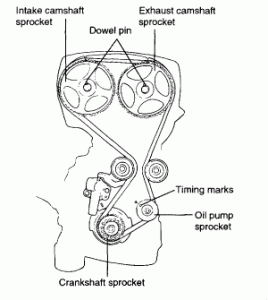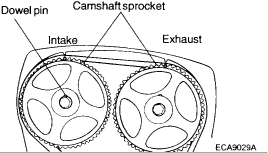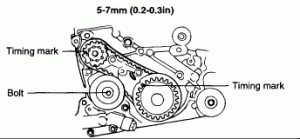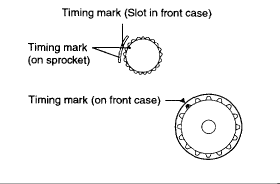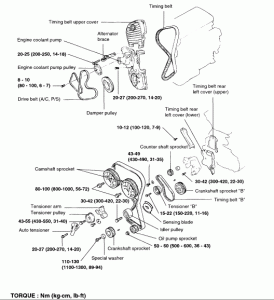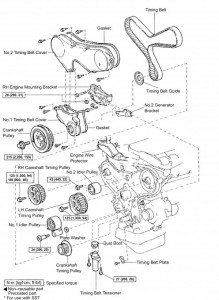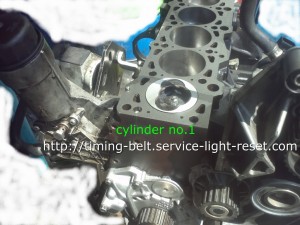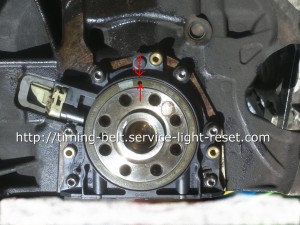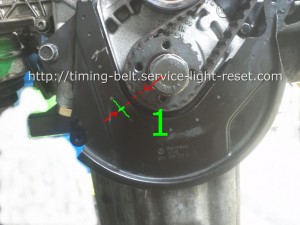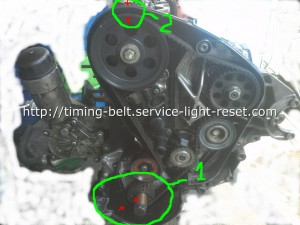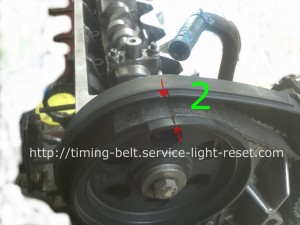How to replacement timing belt replacement diagram for 2003 hyundai santa fe 2.4 16 valve
Toyota Camry 5SFE Engine Timing Belt, Water Pump & Seal Replacement
Introduction
The Toyota 5SFE motor is a 4 cylinder 2.2 liter timing belt driven double overhead cam engine design. This motor is commonly found in the Camry, Celica, MR2 and RAV4 from 1990 to 2001. The engine is a Non-Interference type meaning damage to either the valves or pistons is unlikely to occur if the belt were to ever brake during vehicle operation. The outlined instructions can therefore be used on belts that have broken. Positioning the Camshaft Sprocket and the Crankshaft Pulley for Top-Dead-Center (TDC) alignment is all that is needed for broken belt replacement.
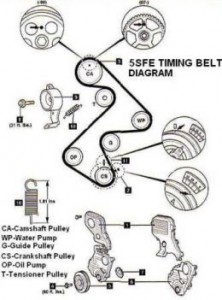 Expect to spend approximately 3 hours for just a belt replacement. Replacement of the water pump (approximately 1/2 hour) and sprocket seals (approximately 1/2 or less per seal) can vary.
Expect to spend approximately 3 hours for just a belt replacement. Replacement of the water pump (approximately 1/2 hour) and sprocket seals (approximately 1/2 or less per seal) can vary.
The belt replacement interval for the 5SFE engine is either 60,000 or 90,000 miles based on the year of vehicle manufacture. Perhaps the introduction of Highly Saturated Nitrile (HSN) Timing Belts adopted for used on Toyota vehicles raised the service interval. Also the time since last replacement should be considered as well. Belt replacement every 6 to 7 years is recommended if under the mileage threshold.
It is recommended that the two Idler Pulleys (one for belt tension and the other as a belt guide) be replaced with every belt change. If the bearings in any of the pulleys were to lose its lubricating properties, the pulley can either wobble placing undue stress on the timing belt or potentially seize guaranteeing belt failure. Worn bearings can be noticed by a pitched grinding noise during engine warm up. When whatever grease remaining inside the bearing lubricates the bearings through engine heat, the noise will disappear. This can be considered a warning to have the belt and bearings replaced as soon as feasible.
Although many dealerships and private service stations recommend Water Pump replacement with the Timing Belt, based on personal experience, the AISIN Water Pumps in Toyotas are very durable. If the coolant has been changed per manufacturer’s recommended interval, and no hard mineral water used, the pump seals and bearings should last over 150,000 miles. This is based on personal experience with many 5SFE belt replacements jobs. However, the pump can be examined for wear and leakage after the Timing Belt Cover has been removed with the Timing Belt. Look for leakage from the weep hole, any chirping noise from the pump when the engine is running and any drag on the pulley when turned by hand after the timing belt has been removed.
On 5SFE engines with over 100,000 miles, there is a good possibility of oil seal wear for the Camshaft, Crankshaft and Oil Pump. The seals are inexpensive but can be time consuming to replace. If the leakage is very bad, oil will get on your Timing Belt which may cause pre-mature belt failure. Moreover, check the Side Engine Control Rod (commonly referred to as the Dog Bone) along with the front engine mount which dampens the the forward and backward flexing of the engine. The rubber vibration dampener has a tendency to dry rot and crack with age. A simple test is to ‘blip’ the engine with the transmission in gear while having your foot on the brakes. If the engine lifts up and settles back down, a new front mount may be in order. Replacement is simple and straightforward. Otherwise, the exhaust system’s flex pipe may eventually crack leading to expensive repairs.
The cost of the belt and components can vary. For Japanese OEM parts: Mitsuboshi Timing Belt, Koyo Pulleys and Aisin Water Pump. Shop and compare prices including shipping costs for the best deals. The belt manufacturers Gates and Dayco, OEM suppliers for Car companies like Honda, are very good and their belts can be had for approximately $15. A Timing Belt Component Kit (Belt, Idle Pulley & Tensioner Pulley) around $50. Water Pumps … around $30, Oil Seals … around $5 each. The parts that comprise a Timing Belt Component Kit for the 5SFE is interchangeable with the following Toyota vehicles:
CELICA (1999)
CELICA GT (1987 – 1998)
CELICA GTS (1990 – 1992)
CELICA GTS SPORT (1990 – 1993)
CELICA ST (1987 – 1989)
MR2 (1991 – 1995)
RAV4 (1996 – 2000)
SOLARA (1999 – 2001)
How To Timing Belt Replacement – Camry / Avalon / ES 300 / Sienna / RX 300 / Solara – V6 – MZFE
Introduction
The Toyota MZFE engine is either a 3.0 or 3.3 liter transversely mounted, timing belt driven, 24 valve dual single overhead cam aluminum V6 design. This engine has been developed for use in many Toyota vehicles from 1994 to 2003. These include the Lexus ES300, RX300, and the Toyot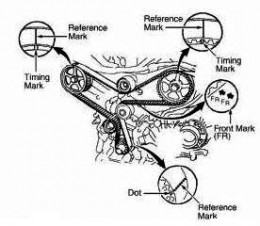 a Camry, Avalon and Solara. The 3.3 liter version was introduced as the 3MZFE. Most engine components in the 1MZFE are interchangeable with the 3MZFE including the timing belt, tensioner pulley and guide pulley. However, the 3MZFE has a different automatic belt tensioner configuration which is not covered in this article. Up until the introduction of VVTI (Variable Valve Timing) technology, the engine’s valve train were Non-Interference. This means that damage to either the valves or pistons will not occur if the timing belt were to brake during vehicle operation. The outlined timing belt replacement instructions can therefore be used on belts that have broken on non VVTI engines. Positioning the Camshaft Sprockets and the Crankshaft Pulley alignment marks to Top-Dead-Center (TDC) is all that is needed before the new belt is installed. A compression leakage test can be performed after belt installation to verify the integrity of the valves.
a Camry, Avalon and Solara. The 3.3 liter version was introduced as the 3MZFE. Most engine components in the 1MZFE are interchangeable with the 3MZFE including the timing belt, tensioner pulley and guide pulley. However, the 3MZFE has a different automatic belt tensioner configuration which is not covered in this article. Up until the introduction of VVTI (Variable Valve Timing) technology, the engine’s valve train were Non-Interference. This means that damage to either the valves or pistons will not occur if the timing belt were to brake during vehicle operation. The outlined timing belt replacement instructions can therefore be used on belts that have broken on non VVTI engines. Positioning the Camshaft Sprockets and the Crankshaft Pulley alignment marks to Top-Dead-Center (TDC) is all that is needed before the new belt is installed. A compression leakage test can be performed after belt installation to verify the integrity of the valves.
Toyota recommends belt replacement at or over 90,000 miles. Of the MZFE engines that were worked on, all cars under 200,000 miles had good operating water pumps. Over 150,000 miles, some of the guide and tensioner pulleys were indicating signs of wear and needed replacement.
Allocate 3 or more hours for just a belt replacement. Paint marks on the belt where it meets the crankshaft and camshaft pulleys will eliminate a lot of grief if any of these pulleys were to move after belt removal and during new belt installation.
1MZFE Timing Belt Components
Tools and Parts Needed
Tools
Impact Driver (Electric, Compressed Air, or Mechanical)
1/2″ Breaker Bar (if no Impact Driver available used for Crankshaft Pulley Bolt removal)
1/2″ & 3/8″ drive Socket Wrenches
Metric Box Wrenches & Sockets
1/2″ & 3/8″ Wrench Extensions
Screw Drivers
Jack (Hydraulic or Scissor)
Standard Jack Stands
Japanese cars use the following metric sizes:
10mm, 12mm, 14mm, 17mm, 19mm, 21mm, 22mm
Needed Parts
Replacement Timing Belt
Timing Belt Cover Gasket (Optional)
Engine Control Rod – “Dog Bone” (Optional)
Belt Tensioner Idler Pulley (Optional)
Belt Guide Idler Pulley (Optional)
Accessory Belts and Crankshaft Pulley Removal
- Place transmission in Park, apply the parking brake and chock the rear wheels.
- Support the vehicle on a jack stands and remove the passenger side front wheel.
- Unbolt the Front Fender Apron Seal – passenger side.
- Unbolt the Crankshaft Pulley Bolt. Use a breaker bar secured to the ground or frame of the car if an impact driver is not available. “Thump” the ignition around 1 second. The tension on the bolt should be relieved as a result of the torque from the starter motor. If that doesn’t work, applying heat to the bolt from a propane torch can help … but be careful … the oil seal can be damaged from too much heat. If the car has a weak battery, not enough amperage is available for the the starter motor to unbolt the pulley bolt. Additional amps can be had by jumping another battery from another car. As a last resort, find a friendly garage owner who’ll torque the bolt off for you with their 180lbs air powered impact driver.
- Turn the engine clockwise to align the crankshaft pulley to the Top-Dead-Center (TDC) mark on the timing belt cover. Use a 1/2 drive socket wrench attached to the pulley bolt to ease engine rotation. Use a impact driver or do a quick twist of the socket wrench counter clockwise to spin off the crankshaft pulley without upsetting the alignment.
- Unbolt the crankshaft pulley.
- (Supplemental) – if your Power Steering Fluid has turned black, the fluid can be replaced with the timing belt replacement job. More fluid can be drained in lieu of draining from the reservoir. Remove the hose clamp and hose from the metal tube located below the crankshaft pulley. The majority of the fluid can be ‘pushed’ out by rotating the steering wheel to the left and right while the fluid is draining out. When completely drained, reconnect the hose and clamp.
- Loosen or remove the Power Steering Pump Bracket Bolt.
- With either a long metal or crow bar, apply pressure to the left side of the pump to relieve tension on the Power Steering Belt. Alternatively, a few light taps with a hammer on the power steering pump bracket behind the ps bracket will move the pump forward of the bolt and relieve tension on the belt.
- Loosen the tension on the Alternator Adjustment Locking Bolt.
- Relieve tension on the Alternator Pivot Bolt.
- Turn the Alternator Belt Adjustment Bolt counter clockwise until the alternator belt can be removed by pushing down on the alternator.
- Remove both the Alternator and Power Steering Pump Belts.
Timing Belt Cover and Side Engine Mount Removal
- Disconnect the Coolant Reservoir Hose from the Reservoir container.
- Disconnect the two engine ground wire connectors.
- Unbolt and remove the side engine mount.
- Remove the alternator bracket nut and bracket.
- Optional – Detach and move the power steering hose to the firewall.
- Unbolt and remove the lower timing belt cover.
- Unbolt and remove the upper timing belt cover.
- Unbolt and remove the side engine mount. Keep the one side engine mount long bolt in place while removing the mount.
- Remove the timing belt guide.
Timing Belt Removal
- Check that the camshaft alignment marks match the backing plate alignment marks. If not aligned, screw back in the crankshaft bolt and rotate the engine with a wrench until alignment is made.
- Optional – When alignment has been made, apply paint marks to the camshaft, crankshaft, backing plate alignment marks along with the timing belt. These will help with re-alignment problems if the crankshaft or camshafts were to move during belt installation.
- Unbolt the timing belt tensioner.
- Simultaneously twist the timing belt between the right camshaft and crankshaft -and- the right camshaft and left camshaft approximately 45 degrees. This will slightly move both camshafts clockwise to ease belt removal as well as new belt installation. A small amount of slack will now exist between both camshafts and the right camshaft with the crankshaft.
- Remove the old timing belt.
Addendum – Water Pump / Guide Pulley & Tensioner Pulley Replacement
If replacement of the Water Pump is desired with the belt replacement, a 10mm stud removal tool will be needed. This tool will ease removal of the pump’s mounting stud thereby allowing the pump to clear the Camshaft Side Timing Belt cover. If this stud is not removed, there will not be enough clearance for the pump to be moved away from the Camshaft Side Timing Belt Cover. Some people will remove the Camshaft sprockets and then the belt cover before removing the pump … extra work and unnecessary if the pump mounting stud is removed.
From my experience, the Camry’s Aisin Water Pumps are good for at least 200,000 miles. Never encountered one go bad at or around 100k miles.
If you purchased a Timing Belt Component Kit, your kit should include a new Timing Belt Guide Pulley (the pulley between the two camshaft sprockets) and Tension Pulley (between the crankshaft and left camshaft). The Guide Pulley can be easily replaced by unbolting the old and bolting on the new. The Tension Pulley is slightly more difficult. This pulley is part of an assembly that allows the pulley to dynamically apply continuous pressure on the timing belt (via the tensioner) if any belt stretch were to occur. The tensioner mounting bolt runs through a sleeve that allows the pulley to moves approximately 30 degrees to take up belt slack.
New Timing Belt Installation
- Start by installing the new belt on the right camshaft using the paint line on the new belt. Prevent the belt from slipping off by using a spring loaded plastic alligator clip.
- Stretch the belt and slip the belt onto the left camshaft. Again, use the paint line on the new belt for alignment and use a plastic alligator clip to prevent the belt from slipping off.
- Guide the right side of the belt over the water pump and then position the belt on the crankshaft pulley cogs. There should be little to no slack when this is done. If so, the belt may be loose by one cog.
- While holding the belt in place over the crankshaft pulley with the right hand, use the left hand to slip the left side of the belt over the tensioner pulley.
- Bolt on the timing belt tensioner. Applying equal turns on each bolt will gradually compress the tensioner pin against the tensioner pulley assembly. As this occurs, the timing belt will tighten up.
- Optional – At this point the car can be started to check for belt alignment. If the car misfires or the Check Engine light were to come on, turn off the car, connect the crankshaft pulley bolt and rotate the engine with a ratchet wrench to the alignment marks. Being off by one cog will cause an engine misfire. This is usually between the right camshaft and the crankshaft.
- Reverse the outlined instructions to reconnect removed components as outlined in the last thumbnail photo in this article. The Crankshaft Pulley Bolt can be ‘shocked’ torqued on with a Mechanical Impact Driver if either an air or electrically powered impact driver is not available. This tool may be available for rent at a auto retailer; otherwise, you can always bring your car to a private garage to have them torque the bolt on for you. Usually they’ll do it for free out of professional courtesy.
- If the power steering fluid was drained, pour in new fluid and turn the steering wheel right to left to create suction. The fluid level should drop, add more fluid and repeat procedure until the fluid level has stabilized.
What is a Timing Belt and When Should it Be Replaced?
We all do the best we can to protect our vehicles and we all make sure to keep them maintained against all possible threats and dangers. However, it should not be surprising to learn that one of the greatest dangers to high mileage cars is also one of the least well known. While we expect and try to prevent cases of engine or transmission failure, the death of many older or high mileage cars is nothing other than a failure of the timing belt. However, in order to understand what makes the timing belt so important and how we can prevent it from failing, we first need to learn a little bit about what it does and what we should expect from specific car models when it comes to life expectancy of the belt.
The timing belt serves a very important part when it comes to making your engine run. Namely, the timing belt is the belt that controls the camshafts in your engine and keeps the entire operation running smoothly. Note that timing belts are present in engines with overhead cams, and are essential to keep these cams turning at the right time in order to keep the engine running. Remember that a camshaft is the shaft that opens and loses the intake and exhaust valves in your engine, both letting air in to create combustion, and venting the exhaust that comes from those explosions. A timing belt must be properly calibrated in order to move in time with the motion of the pistons.
When it comes to engines, the two most important terms to remember when talking about timing belts are “interference” engines and “non-interference” engines. Interference engines have a very, very small amount of space between the valves and pistons, while non-interference engines tend to have a lot more room.
The different types of engines make a major difference when figuring out how bad a timing belt failure can be for your engine. In an interference engine, with little space between the valves and pistons, a slip or break in the belt can send a piston flying into an open valve. When this happens, it is similar to the engine self-destructing, as it will soon become nothing more than an unusable mess of metal. This is not to say, however, that a timing belt failure in a non-interference engine will not be damaging, as it can still cause a great deal of damage to many engine components. Generally speaking, however, a timing belt failure in a non-interference engine will not cripple the motor.
Regardless of what type of motor is present in your car, a failure in the timing belt will cause the engine to suddenly stop. This means that your car will suddenly stop running and you will not be able to get it started again. In all cases, this means calling a tow truck to come pick up your now non-running vehicle.
If all of this sounds like a nightmare, that’s because it can really urn out to be one. Luckily though, timing belt failure is somewhat easy to prevent, and although it may not be the cheapest or easiest operation in the world, it is definitely a better option that purchasing either a new car or a new engine.
Of course, checking to see when your timing belt was last changed is not always the easiest task either. If you have owned your car, and have ever had it replaced in the past, you should have the mileage written down as to when it was changed. If, though, you purchased your car used, there may be a sticker located under the hood of your car that gives the mileage of the last change. If you cannot find this sticker, than it may be better to have the belt changed, just to be on the safe side. If you have the owners manual for your vehicle, it should detail when the belt should be changed.
If you have trouble finding out when exactly the belt should be changed; you could consult either a local mechanic or contact a dealership for the exact number. A good general rule of thumb is that a timing belt should be changed every 60,000 to 75,000 miles, although some belts are designed to last up to 100,000 miles before requiring a change. Regardless though, it is best not to let a belt go more than 80,000 miles or so, even if the recommended change point is a lot higher. Changing your belt early is definitely a lot safer for your engine, and a little money out of pocket can save you a lot of money and a new car in the long run.
Remember, even though you may get your oil changed every 3,000 miles, and do all of your scheduled repair services, nothing can save you from a timing belt failure. Make sure to get your timing belt replaced regularly and by a certified mechanic. It can mean the different between a good running car and useless piece of metal.
Timing belt diagram for Volkswagen Crafter 2.5
Short instructions:
1. cylinder no.1 on top (picture 3)
2. Lock cylinder no.1 crankshaft position (picture 4,8,9 and 10)
3. Lock cylinder no.1 camshaft position (picture 1,2 and 5)
4. Ring crankshaft position (after having done step 2.) take a look at picture 6
Soon on this page we will post timing belt diagram and replacement instructions for Volkswagen Crafter 2.5.
Currently working on this project, please visit us soon.
What Are the Potential Dangers and Costs of Not Replacing Your Timing Belt Regularly?
Expensive damage can be caused to your engine: Many timing belt engines are “interference motors”, which simply means that the valves would hit the pistons if not kept in proper timing. This is not a problem under normal operating conditions but if the timing belt were to break or jump off the gears, the valves of one or more cylinders would strike the pistons and cause severe and costly damage.
If your car has more than the recommended mileage on the timing belt, you may be operating your car on borrowed time and the cost of replacing the belt is MUCH cheaper than having to rebuild or replace the engine because of damage caused by a snapped/worn timing belt.
Parts can be hard to find to repair damage caused by a failed timing belt: It’s obvious that timing belt replacement as a preventive maintenance measure is often ignored. This is so prevalent, in fact, that many car manufacturers and engine parts manufacturers don’t stock major engine components for timing-belt engines after the required 5-7 years because there will be only a handful of these cars still on the road. It can be quite difficult to find crankshafts, pistons, connecting rods, camshafts and the like for these older engines due to the economic infeasibility for the manufacturers to continue producing these parts for the few cars that they estimate will still be on the road.
In fact, many car manufacturers don’t expect timing-belt driven engines to last through more than two timing belts or approximately 120,000-150,000 miles and, moreover, they actually expect many to be taken out of service with the original belt still installed. Sadly, there are hundreds of thousands of 85,000-90,000 mile timing belt cars in junkyards because the timing belt was never replaced. What a waste when these cars could still be enjoying a useful life had the owner just paid attention to the recommended mileage replacement intervals for the timing belt.
Know What You Are Doing
Many of today’s autos have timing belts. If you keep up with all the necessary services today’s automobiles are engineered to last well over 100,000 miles. Your auto, being in good shape now has 50,000 plus miles on it and you plan on keeping it. You will now have to consider the big expensive service. The Timing Belt.
This timing belt is made of the same basic materials that the other drive (fan) belts are made of. The timing belt is probably one of the more expensive and more important maintenance items you will have to do. Follow your manufacturer’s time and mileage recommendations for this service. Many of today’s engines are called “interference engines”. This means if your timing belt skips or breaks the valve and pistons are no longer in sync and will hit each other causing very extensive damage internally to the point of having to replace the complete engine itself.
If you plan on replacing the timing belt yourself you best be very mechanically inclined. Replacing this belt on a four cylinder engine is not all that difficult if you know what you are doing. Replacing this belt on a six cylinder engine, especially a transverse engine, can be over bearing for the average backyard do-it-yourselfer. If the engine is not an interference type and belt timing is off by a few teeth the worse that will happen is the engine not running properly and the belt has to be re-timed. If the engine is an interference type and the belt is off by too many teeth the valves and piston will hit each other, so by trying to save money you have just ruined the entire engine. Think twice or three times before attempting this belt replacement by yourself. Some things are better left to pros even if it costs more. Don’t forget, at least this way you have a certain warrantee on the repair should something go wrong.
Choosing not to do the timing belt when the service is due can lead to the same engine damage should this belt skip a few teeth or break from age
Timing Belt Problems – How to Solve Them
Are you facing timing belt problems? Well, this is a rather serious matter because your engine is largely dependent on the smooth running of the timing belt. The timing belt connects the crankshaft, the walls, the camshaft and the Pistons all together. So if one is “out of caliber” there is a chance that you might find yourself having an engine seizing at odd moments. That is because the synchronization which is timed to run in a very well coordinated motion has been disturbed. That is why you need to know all about timing belt problems and how they need to be solved immediately so that your engine does not break down right in the middle of the road.
One of the most common of timing belt problems is not replacing it in time. Your timing belt is going to face the normal wear and tear of any hard worked car component and is going to give way during the passage of time. So it is necessary to get the professionals are expert or mechanic to check out your timing belt problems and replace them whenever necessary. He is going to replace any damaged, cracked or badly worn timing belt.
When To Replace Your Timing Belt
Timing belt replacement is the “must-do” service operation which every car owner should know about. Along with that knowledge, we should be aware of whether our engine is considered an interference engine or not. These two bits of information can, at a minimum, save us from unexpected breakdown and in the extreme can help us avoid thousands of dollars in repairs.
Without getting too technical, the synchronization between two internal engine parts (the crank and cam shafts) is accomplished with the help of the timing belt. In the process of these two parts moving the valves open and close in close proximity to the pistons. This constitutes an interference engine, because if the timing belt jumps a tooth on the sprocket on which it rides or the belt fails altogether the valves and pistons will “interfere” with each other.
This collision will cause major damage to the engine. The repair bill will, on older vehicles, often exceed the value of the car. On the other hand, a car whose engine is not configured this way will simply lose power or will not start. While this might be more desirable than facing huge repair costs, it is something that is better avoided if possible.
The motivation for preemptive replacement of the timing belt is obvious. But how do you know when to replace it? There is always the owner’s manual which will indicate mileage of anywhere from 50,000 to 90,000 miles. For a comprehensive list of timing belt service intervals and the type of engine (interference or not) check out About.com.
Some other considerations relative to timing belt replacement are:
1) Is the vehicle leaking any type of fluid that might degrade the belt, if so disregard the suggested replacement interval and replace the belt ASAP as well as repair the leak;
2) Do you know the repair history of the vehicle if it is not verifiable err on the side of safety and replace the belt;
3) Timing belt replacement can be labor intensive. Since the water pump is usually accessed in the same operation you might consider replacing the pump at the same time even if it doesn’t leak. You will save on labor and possibly prevent a pump replacement later on that will also necessitate the belt to be replaced again;
4) To avoid subsequent failure consider replacing sprockets and tensioners that are part of the timing belt system. All components are sometimes sold as a kit and can be less expensive than purchasing them individually.
All service intervals should be followed in order to protect your investment and maintain the integrity of your warranty. In the case of the timing belt, it just makes sense.
Timing Belt Symptoms
Timing Belt Symptoms
A timing belt handles the timing of the engine’s valves. If a timing belt snaps, certain kinds of engines could be damaged. It’s better to replace the timing belt if you have hit the amount of miles your vehicle manual recommends for a replacement, or if you notice some symptoms signaling which the timing belt is going bad.
There’s two different kinds of engines: interference and non-interference. In case your timing belt snaps or slips on an interference engine, the engine is going to be badly damaged costing a small money in repairs. In case a timing belt snaps on a non-interference engine, the engine is going to be damaged but won’t cost too much in repairs as an interference engine.
The failure of a timing belt is probably the most typical main reasons why cars breakdown. If you’re acquainted with the timing belt, the way it functions and the way to recognise whether or not some thing is wrong with it, you’ll be able to avoid serious damage to your vehicle and you will know when you should replace it. Know-how about timing belt symptoms could save you from having to experience being stuck on the side of a road due to a broken timing belt.
With no correctly functioning timing belt, an engine’s pistons would stop to operate therefore a vehicle will be not able to work. Worn timing belt can’t perform its job appropriately for this reason old timing belts can result in performance issues with a vehicle.
Now there are several timing belt symptoms to take into consideration: if the car’s engine vibrates a lot which it leads to the whole car to shake, in case your car starts belching much more exhaust than normal, if you encounter difficulty in starting the car or in the event you hear strange noises from the car’s engine. These types of are just some of the common timing belt symptoms. In the event you encounter one or more of those it might be ideal to consult with a mechanic as quickly as possible. Other timing belt symptoms can vary then one of them is emitting of excess smoke. When your car emits smoke a lot more than the usual that is a sign which your timing belt could have a issue.
These are the basic timing belt symptoms that you need to watch out for if you wish to prevent causing major damage to your car’s engine. Some of the reasons for timing belt damage are oil leak and getting too hot. To prevent these issues it’s better which you carry out regular check-up for your vehicle. If you’d like to learn more about timing belt as well as other timing belt symptoms, you could browse the internet for websites which has this type of information.
If you have ignored the symptoms and your vehicle conks out and stops running it’ll probably are already too late. So keep in mind, at the time you notice these timing belt symptoms it might be better to get your car checked. Awaiting the damage to become severe is certainly not something you will want to do.
